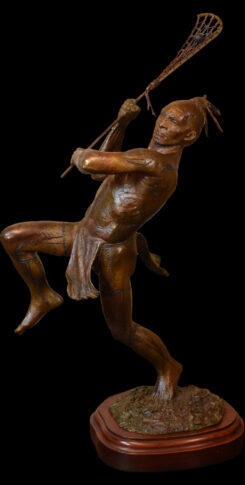Bronze edition: 20 | Height: 28″
Seneca Warrior (c. 1708 ? – 1798)
Guyasuta was conspicuous at the defeats of General Braddock (1755) and of Major Grant at Fort Duquense (1758), the battles of Bushy Run and Devil’s hole in 1763, and the destruction of Hannahstown, Pennsylkvania during the Revolutionary War in 1782. Early chronicles describe the great Indian uprising against the British in 1763 as the Pontiac and Guyasuta War.
There is no time to be lost. Let us strike immediately!”
“The English treat us with much disrespect and we have the greatest reason to believe, by their behavior, they intend to cut us off entirely; they have possessed themselves of our country, it is now in our power to dispossess them and recover it, if we will but embrace the opportunity before they have time to assemble together and fortify themselves. There is no time to be lost, let us strike immediately!”
Guyasuta to the Wyandots and Ottawas, Detroit, July 1761
“With so many causes to irritate their restless and warlike spirit, it could not be supposed that the Indians would long remain quiet. Accordingly, in the summer of 1761 a deputation of Senecas,” led by Guyasuta, came to instigate the Ottawas and Wyandots to destroy Detroit. This “proved to be a precursor of a tempest.” By early 1763, “a ferment of indignation at once became apparent and within a few weeks a plot had matured such as was never before or since conceived or executed by North American Indians. It was determined to attack all the English forts and outposts [West of the Appalachians] upon the same day; then having destroyed the garrisons, to turn upon the defenseless frontier and ravage and lay waste the settlements until, as many of the Indians fondly believed, the English should all be driven into the sea and the country restored to its [original] owners.”
Francis Parkman, “The Conspiracy of Pontiac”, 1851
Though it is difficult to determine which tribe was first to raise the war cry, the Delawares and Senecas were most incensed and the Seneca chief Guyasuta was perhaps foremost to apply the torch. Early chronicles describe it as the Pontiac and Guyasuta war. Under their leadership as many as 17 different tribes came together in common cause and within a short time eleven of the fourteen forts and outposts were destroyed; Detroit, Niagara and Fort Pitt only held out and each of these was cut off and surrounded.
Though Pontiac’s great conspiracy ultimately failed, the Senecas struck perhaps the severest blows of the way, destroying Forts LeBoeuf, Venago and Presque Isle and at Devils Hole almost annhilated two British detachments on the newly cut road along the cliffs above the swirling waters below Niagara Falls.
Guyasuta, uncle of Chief Cornplanter and the Seneca prophet Handsome Lake, was conspicuous at the defeats of General Braddock (1755) and of Major Grant at Fort Duquesne (1758), the battles of Bushy Run and Devils Hole (1763) and the destruction of Hannahstown, Pennsylvania during the Revolutionary War in 1782. At the outset of the Revolution he served as the spokesman for the Iroquois League speaking to the Americans: “I am appointed by the Six Nations to take care of this [the Allegheny and Ohio] country and I desire you will not think of an expedition against Detroit (held then by the British) for, I repeat, we will not suffer an army to pass through our country.” Soon after, Guyasuta took up arms against the Americans and decorated the Seneca towns of the upper Allegheny with the scalps of hundreds of settlers.
“When I was young and strong our country was full of game which the good spirit sent for us to live upon. The lands which belonged to us were extended far beyond where we hunted. Hunting then was not tiresome; it was diversion; it was pleasure. When fathers asked for land from my nation, we gave it to them, for we had more than enough…but now he [Guyasuta] is grown old. He is very old and wonders at his own shadow; it has become so little. He has no children to take care of him and the game is driven away by the white people…”
Guyasuta, 1790





